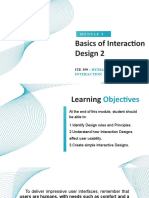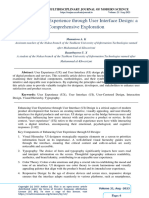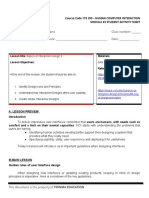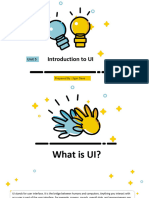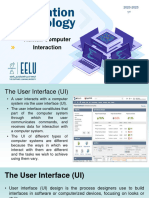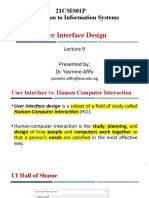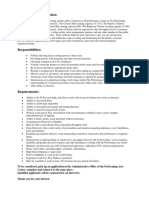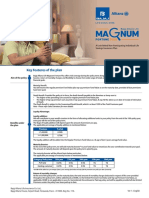ADE413 MULTIMEDIA DESIGN
INDIVIDUAL ASSIGNMENT
REPORT ON TOPIC SELECTED:
TOPIC 2: USER INTERFACE (UI) PRINCIPLES EVERY DESIGNER
MUST KNOW
Name : Nurul Nadzira binti Mohd Farid
Student ID : 2023945459
Course : ADE413 Multimedia Design
Course Group : NADCA4A
Lecturer : Sir Saiful Bahar bin Salim
Faculty : Faculty of Architecture, Planning and Surveying
Programme : Bachelor of Science in Construction Management (CFAP246)
1
� Table of Content
1.0 Introduction
2.0 User Interface Principles Designers Must Know
3.0 Conclusion
4.0 Reference
1.0 Introduction
What is User Interface (UI)?
The UI, also known as user interface, is the point of contact and communication
between a user and a computer. This includes visual elements such as tablet, handphone,
laptop, display screens, keyboards, a mouse, and the look of a computer desktop. It is also
how a person interacts with an application or website.
As web and mobile applications has become increasingly important for many
businesses, business owners are placing more emphasis on making the UI as intuitive and
user-friendly as possible to enhance the user experience thus, expanding their business and
reaching their target user effectively.
2
� 2.0 User Interface (UI) Principles Designers Must Know
2.1 Clarity
Clarity over complexity. Clarity is an essential part of a great UI design, from
identifying interactive and static elements to making navigation easier. There should be no
confusion throughout the interface for the user understanding. Designer must keep the
interface straightforward and clear, thus motivating user to keep on interacting with the
interface.
2.2 Familiarity
Good interfaces are the one user are familiar with. Users usually rely on interfaces
and elements that is familiar to their usual digital experience. The easier and more familiar
they are with understanding the website or app, there are high chances they will come back
to it. The less time users have to spend learning how the interface works, the quicker they
can start using the service or product stated. This will also minimize the chances of them
moving on to the next website due to the complexity of the interface.
2.3 User Control
It is important to place users in control of the interface. Users frequently pick system
functions unintentionally, and they will require a clear "emergency exit" to navigate out of the
current system functions without having to spent time restarting the process. In this
case, undo and redo function (Nielsen, 2020). This statement means providing users with
different options to undo when they feel they made an error. For example, when creating
forms, designers need to allow users the option to click ‘back’ to go back to previous page or
tab. Another example is to provide the ‘exit’ button clearly on website overlays (Refer Figure
1). If not, users might just click the previous button and go back to the homepage instead of
just exiting the overlay.
3
� Figure 1
Example of clear exit button on a website overlay.
2.4 Hierarchy
Strong visual hierarchy is a core design principle of a good user interface. It consists
of organizing visual elements in a way that indicate the level of importance of each particular
element and guide users to take action required. It enables the users to distinguish the most
important information first, then the second and so on. Some of the elements include:
• Colour – bright colour stands out the most and can be used in neutral colour
schemes to give contrast, thus leading users to take certain action.
• Size – bigger element like button provided, creates more importance than smaller
button.
• Fonts – Try to use various font sizes, styles and weights to create visual hierarchy.
For example, take a look at Odoo website main headline (Refer Figure 2), which
uses the biggest font to clearly describes the content, and the word “real” and “CRM”
are written in bold type to highlight the message.
4
� Figure 2
Example of various font size and weight used.
• Negative Space – Negative space draws attention and emphasizes important
elements. Do not squeeze all the objects and elements on the screen together;
instead, give them some breathing room.
2.5 Accessibility
There are over 1 billion people that have disabilities worldwide, that is why
accessibility is a crucial factor when designing user interfaces. Creating accessible user
interfaces means making them useful for people with disabilities. Those with cognitive or
neurological related conditions, as well as those with hearing, visual, or movement
difficulties, are all considered while designing with accessibility in mind. Designers can make
their interfaces more accessible by using features like colour contrast, larger font sizes, and
alternative text for images. For example, Voice over like Alexa or Siri, offers visually impaired
users to navigate their products using spoken descriptions.
5
�2.6 Flexibility
Flexibility is a key principle of user interface (UI) design, from designing solutions that
work well in all situations (from an old computer or tablet like iPad) to using shortcuts that
speed up interaction for users. Ideally, not only user interface (UI) design should be easy to
learn for new users, but it must also include accelerators to help advanced users enhanced
their tasks. In short, designers must make sure that their design is flexible and efficient for all
types of users, from beginners to experts, and also, devices like mobile, laptop, tablet or PC.
3.0 Conclusion
An excellent user interface (UI) design creates a seamless environment in which
users may grow, but the design itself is almost unnoticed. Good designers understand that
adhering to user interface (UI) design principles like those discussed above can help to
produce a more effective user interface, enabling interaction to the point where the users
scarcely notice the interface at all.
In conclusion, user interface design principles are crucial for creating user-friendly,
functional, and aesthetically pleasing interfaces. These principles discussed above, assist
designers in creating interfaces that are simple to use, navigate, and understand, resulting in
better user engagement, satisfaction, and product success.
6
� 4.0 References
Chappal, M. S. (2021, May 26). The 6 Key Principles of UI Design. Retrieved from In The Loop by
Maze: https://maze.co/collections/ux-ui-design/ui-design-principles/
Churchville, F. (2021, September 15). definition of user interface (UI). Retrieved from
TechTarget | App Architecture:
https://www.techtarget.com/searchapparchitecture/definition/user-interface-UI
Fleck, R. (2021, December 6). 10 Fundamental UI Design Principles You Need To Know.
Retrieved from dribbble: https://dribbble.com/resources/ui-design-principles
Mukherjee, P. (2023, April 14). The Most Important UI Design Principles Every Designer
Must Know. Retrieved from Medium.com:
https://medium.com/@theupbeatdesigner/the-most-important-ui-design-principles-
every-designer-must-know-cb8225edc937
Nielsen, J. (2020, November 15). 10 Usability Heuristics for User Interface Design. Retrieved
from Nielsen Norman Group: https://www.nngroup.com/articles/ten-usability-
heuristics/


